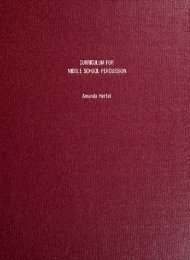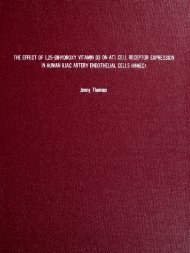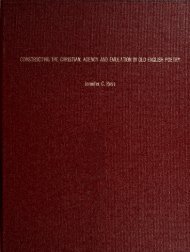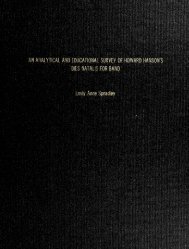Motionless as an Idol - Columbus State University
Motionless as an Idol - Columbus State University
Motionless as an Idol - Columbus State University
- No tags were found...
You also want an ePaper? Increase the reach of your titles
YUMPU automatically turns print PDFs into web optimized ePapers that Google loves.
Bullock 13essence, both necessary steps if men are to fully possess <strong>an</strong>d control the female sexualitythat threatens them. Caddy resists domination but stillsuffers under its force."A Rose for Emily"Miss Emily, in Faulkner's story, "A Rose for Emily," suffers like Caddy under theforce of domin<strong>an</strong>t male influence throughout her life.William Faulkner utilizesmetaphors of art to demonstrate the confinement that Miss Emily experienced in her town<strong>an</strong>d to advocate for her to have a more liberated societal position. Iargue that Faulknersupports the feminist cause, although he often c<strong>as</strong>ts his opinions <strong>an</strong>d reformativesolutions in metaphor. Faulkner uses these metaphors to achieve a dual, yet connected,purpose. The first part of that purpose elaborates on Faulkner's idea about art <strong>an</strong>d theemph<strong>as</strong>is the artistic concepts put on Miss Emily's position within her patriarchal society.One idea pertinent to the purpose is related to Faulkner's underst<strong>an</strong>ding of the artist'sappropriation <strong>an</strong>d m<strong>an</strong>ipulation of material. Faulkner then applies this underst<strong>an</strong>ding ofappropriation to Miss Emily; by c<strong>as</strong>ting Miss Emily <strong>as</strong> different pieces of art, thetownspeople establish <strong>an</strong>d retain their control over her. The second part of the purposepresents Miss Emily <strong>as</strong> the fulfillment of, <strong>an</strong>d simult<strong>an</strong>eous challenge to, her culture'sstereotypes <strong>an</strong>d expectations related to women. Both dimensions comment on theportrayal of Miss Emily <strong>an</strong>d the society in which she is developed; they each voicespecific concerns regarding the facades imposed upon women in the Americ<strong>an</strong> South.Throughout the story, Faulkner employs several art metaphors, each depicting afacet of Miss Emily constructed by her society. Itis import<strong>an</strong>t to note that the entire storyis told through the voice of the collective narrator, the voice of the townspeople, <strong>an</strong>d,
















